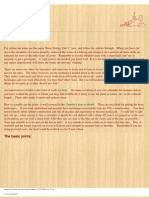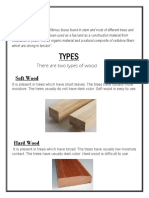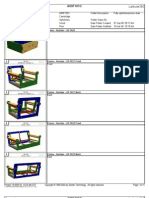Wood Assembly Without Nails or Screws
Wood Assembly Without Nails or Screws
Uploaded by
adamj123Copyright:
Available Formats
Wood Assembly Without Nails or Screws
Wood Assembly Without Nails or Screws
Uploaded by
adamj123Copyright
Available Formats
Share this document
Did you find this document useful?
Is this content inappropriate?
Copyright:
Available Formats
Wood Assembly Without Nails or Screws
Wood Assembly Without Nails or Screws
Uploaded by
adamj123Copyright:
Available Formats
Wood assembly without nails or screws
In woodworking, wood assembly by traditional means without nails or screws yields a more natural, attractive and professional finish. The joining method is chosen according to available tools, knowledge, habits and project, although the same method may be used for various types of projects. Here are a few of the most popular joining methods. Tenon and mortise joint A mortise is a cut made to a stud (female part), whereas a tenon is a part that projects on the end of a rail (male part) and is inserted in the cut. It is possible to insert the rail directly in the mortise (i.e., without giving the rail any particular shape), but usually the rail is sculpted to give it shoulders. The latter are surfaces located on 1, 2, 3 or 4 sides of the tenon, to prevent the latter from pushing in beyond a certain depth, and to stabilize the joint while hiding the contours of the mortise. To provide maximum hold, the tenon may completely pass through the stud, but the end of the tenon will then be apparent, which may be unattractive for some furniture. For an invisible joint, the mortise will not be drilled completely through the stud, to hide the end of the tenon (blind tenon). Popular among cabinetmakers for joining parts of equal thickness when making furniture. Dowel joint This type of joint consists of drilling holes in each part to be joined, and then inserting dowels, which are thus the link between the two parts. Prefabricated dowels come in various sizes (e.g.: diameters of in., in.) and have grooves allowing excess glue to come out. The dowels can also be made by cutting pieces of twigs; their lengths and diameters are more varied than those of prefabricated dowels, and can thus meet specific needs. These dowels will not have grooves, but its easy to trace grooves oneself. By its simplicity and principle, this type of joint can apply to various jobs: assembling boxes, drawers, furniture, frames Dovetail joint
The dovetail joint is made by securing, on one part, trapezoid tenons to be inserted in grooves of the same shape on the other part, so that dove tail-shaped ends show on the latter hence the name. This type of joint provides great strength when the parts are submitted to tractions. Frequently used for joining large parts submitted to tractions; typical for making drawers and boxes.
Lap-joints The principle is very simple: it consists of joining two parts of equal thickness, which will cross each other in T, + or even X patterns, by removing from both parts half their thickness at the point where they will meet. To make a joint that will be more attractive and sturdy than simply superimposing and screwing the two parts. Since the parts surfaces are flush, it is also possible to cover them with panels. Biscuit joint Like the dowel or false tenon joint, this type of joint is based on the insertion of a piece of wood in the parts to be joined. In the present case, the piece consists of a compressed wooden strip (called a biscuit) that enlarges in the slit where it is inserted (thanks to the glues humidity), thus making a very sturdy joint. Very easy and quick to produce, thanks to the biscuit joiner (a specialized tool that is highly accurate), this type of joint is adopted by more and more do-it-yourselfers, from amateurs to professionals. Used for making various assemblies, such as furniture, drawers and cupboard doors, biscuits are particularly suited for joining parts connected by their slice, for example to laterally join several boards intended to form a tabletop. Tongue and groove joint
A groove is made on the entire length of a wooden part, in which is then inserted the tongue that will fit on the entire length of another part. To laterally join boards intended for making panels, tabletops, floors, etc., or to install shelves in furniture and make cupboard doors (see the rail and stile joint).
Rail and stile joint Widely used by makers of kitchen cupboards, this type of joint is directly based on the tongue and groove joint; the two parts to be joined are machined according to complementary forms (or profiles). This variation of the tongue and groove joint has been developed sufficiently to justify its own description. This type of joint, quick and easy to make with adequate equipment (router), provides sturdiness and a large contact surface on which to apply glue. Moreover, not only do you make both the profile for joining parts and the groove for inserting the central panel (following the example of the tongue and groove joint), but you also make the interior finish moulding! Used for making central panel doors (for a variety of cabinets and furniture). To strengthen joints You can, of course, screw or nail the joined parts together to strengthen the joint, but since were interested here in joints without screws or nails, lets see how we do without them Glue Wood or construction glue will strengthen any type of joint. In the case of biscuits, however, glue not only establishes a link based on adherence, but also humidifies the biscuits, which then expand in the slit, thus producing a physical link between the two parts to be joined. Keys This technique, which is similar to that of biscuits, applies to mitre cut joints (e.g.: frames). Kerfs are cut in the joints outer corner and wood tabs are inserted in them. Allow the glue to dry, and then use a back saw or a file to remove tab tips that protrude, while take care not to damage the surface.
Dowels Wood dowels can be used for literally locking a tenon and mortise joint; you have only to drill the joint through and through, and then insert a dowel in the hole. For even more effectiveness, you can make a pull lock: the tenons hole is slightly staggered (by approx. to 1 mm) in relation to the holes drilled in the mortise. During its insertion, the dowel pulls on the tenon, thus leading it toward the mortise. Wedged through joints Wedged through tenon and mortise joints can be strengthened by the insertion of wooden wedges (wood tongues of increasing thickness): slits are cut on the end of the tenon (which thus looks like a fork), the latter is slid in the mortise (which is dug through and through the part), then a wedge is inserted in each slit and tapped in lightly with a mallet. The result is to spread apart the parts of the tenon that form the fork. The mortise can be widened where the tenon exits, which allows the latter to spread apart further, for increased locking.
You might also like
- Ulmia Workbench (55p)Document55 pagesUlmia Workbench (55p)pippitiamo100% (1)
- Shop Work Joinery and CabinetmakingDocument280 pagesShop Work Joinery and Cabinetmakingpastorjmcgouirk100% (2)
- Monarch Full Catalog Mar 2009Document116 pagesMonarch Full Catalog Mar 2009Ankit Biswas100% (1)
- Wooden JointsDocument14 pagesWooden JointsAparna KulshresthaNo ratings yet
- Wooden Joinaries Market Survey....Document51 pagesWooden Joinaries Market Survey....flower lilyNo ratings yet
- A Little Book of Vintage Designs and Instructions for Making Dainty Gifts from Wood. Including a Fitted Workbox, a Small Fretwork Hand Mirror and a Lady's Brush and Comb Box: Including a Fitted Workbox, a Small Fretwork Hand Mirror and a Lady's Brush and Comb Box.From EverandA Little Book of Vintage Designs and Instructions for Making Dainty Gifts from Wood. Including a Fitted Workbox, a Small Fretwork Hand Mirror and a Lady's Brush and Comb Box: Including a Fitted Workbox, a Small Fretwork Hand Mirror and a Lady's Brush and Comb Box.No ratings yet
- All Sorts of Carpentry Joints: A Guide for the Amateur Carpenter on how to Construct and use Halved, Lapped, Notched, Housed, Edge, Angle, Dowelled, Mortise and Tenon, Scarf, Mitre, Dovetail, Lap and Secret JointsFrom EverandAll Sorts of Carpentry Joints: A Guide for the Amateur Carpenter on how to Construct and use Halved, Lapped, Notched, Housed, Edge, Angle, Dowelled, Mortise and Tenon, Scarf, Mitre, Dovetail, Lap and Secret JointsRating: 5 out of 5 stars5/5 (3)
- How to Build Garden Furniture: Plans and Complete Instructions for Making Lawn Chairs, Benches, Settees and a Chaise Longue, Tables, Dinettes and Picnic Sets, Portable and Folding Pieces of All Kinds for Outdoor UseFrom EverandHow to Build Garden Furniture: Plans and Complete Instructions for Making Lawn Chairs, Benches, Settees and a Chaise Longue, Tables, Dinettes and Picnic Sets, Portable and Folding Pieces of All Kinds for Outdoor UseNo ratings yet
- Woodwork Joints How they are Set Out, How Made and Where Used.From EverandWoodwork Joints How they are Set Out, How Made and Where Used.Rating: 5 out of 5 stars5/5 (1)
- Woodwork JointsDocument5 pagesWoodwork JointsAbdul Sukur Kamsir100% (3)
- Cutting A Bridle JointDocument6 pagesCutting A Bridle JointMario BerronesNo ratings yet
- Week 2 - Making A Lap Joint and Dovetail Lap JointDocument6 pagesWeek 2 - Making A Lap Joint and Dovetail Lap JointAndy Joseph StotenNo ratings yet
- Ancient Egyptian Furniture in Context fr-1Document349 pagesAncient Egyptian Furniture in Context fr-1yarasolaiman1995No ratings yet
- Making A Mid Century Modern ArmchairDocument7 pagesMaking A Mid Century Modern ArmchairJB WellsNo ratings yet
- Drawer Book-Runners Guides KickersDocument12 pagesDrawer Book-Runners Guides KickersDillon HartsykerNo ratings yet
- Carpentry Joints (Woodwork)Document16 pagesCarpentry Joints (Woodwork)KadambiniNo ratings yet
- Timber Frame 2Document27 pagesTimber Frame 2ZulHilmi ZakariaNo ratings yet
- Corian & WoodDocument68 pagesCorian & WoodMuhammad SohailNo ratings yet
- Wood AnatomyDocument16 pagesWood AnatomyDennis GilberoNo ratings yet
- World Woods in PDFDocument322 pagesWorld Woods in PDFpitutele100% (1)
- Extraordinary Built InsDocument6 pagesExtraordinary Built Insjindi92% (12)
- Trussed RoofsDocument24 pagesTrussed RoofsKusum RawatNo ratings yet
- Lumber Grading ChartDocument2 pagesLumber Grading ChartKeith BibelhausenNo ratings yet
- Beds - Four Poster Bed PlansDocument8 pagesBeds - Four Poster Bed Planspoimandres100% (2)
- Wood Shop Complete.Document15 pagesWood Shop Complete.Muhammad BurhanNo ratings yet
- Furniture Making, Advanced Projects in Woodwork - 1917Document72 pagesFurniture Making, Advanced Projects in Woodwork - 1917workshopcarpintaria100% (7)
- BC DoorsDocument11 pagesBC DoorsYachika SharmaNo ratings yet
- Digital Patterns: Designed by Steve GoodDocument5 pagesDigital Patterns: Designed by Steve GoodEmilian Baluta100% (1)
- Woodworking Starter Pack Projects For Beginners BestLife52ysaffDocument4 pagesWoodworking Starter Pack Projects For Beginners BestLife52ysaffboattile6650% (2)
- Wood Working Spot On Measuring & MarkingDocument5 pagesWood Working Spot On Measuring & MarkingAmanjotNo ratings yet
- Furni 2 MergedDocument63 pagesFurni 2 MergedRhobie Bulan100% (1)
- Stickley ClassicsDocument144 pagesStickley Classicsgromov.kirill1No ratings yet
- Hidden in Plain View: An Appreciation of The Oak Frame TraditionDocument9 pagesHidden in Plain View: An Appreciation of The Oak Frame Traditiontim4380No ratings yet
- 06 PDFDocument60 pages06 PDFGeorge Vlad AndronicNo ratings yet
- Modern Cabinet WorkDocument516 pagesModern Cabinet Workpastorjmcgouirk100% (1)
- Wood Joints1Document3 pagesWood Joints1Urvashi Bhati0% (1)
- F Orew Ord Summary of Conservation PrinciplesDocument12 pagesF Orew Ord Summary of Conservation PrinciplesJNo ratings yet
- JointsDocument63 pagesJointsEduardo Antonio Almeida Filho100% (1)
- The Art of Woodworking - Cabinetmaking 1992Document148 pagesThe Art of Woodworking - Cabinetmaking 1992ghimpe--100% (13)
- Frame DetailsDocument15 pagesFrame DetailsDora BANo ratings yet
- Your Guide To Shaker Furniture: 3 Classic ProjectsDocument25 pagesYour Guide To Shaker Furniture: 3 Classic Projectsjpl.guedes6842100% (1)
- Arched Aurora NightstandDocument7 pagesArched Aurora NightstandRoberto LandaNo ratings yet
- An Everyday CabinetDocument8 pagesAn Everyday CabinetJonathan Hopkins100% (3)
- Art009 Marquetry C PDFDocument29 pagesArt009 Marquetry C PDFMarcos R. Hernández M.No ratings yet
- Popular Woodworking No 105 November 1998Document92 pagesPopular Woodworking No 105 November 1998EliseuJoséDosSantosNo ratings yet
- Basic Loom PartsDocument3 pagesBasic Loom Partsfarheenfaiz100% (1)
- Vol.13 - Cabinets and BookcasesDocument148 pagesVol.13 - Cabinets and Bookcasessectiune79100% (19)
- 1810 Ridealong All About WorkbenchesDocument20 pages1810 Ridealong All About WorkbenchesJe DNo ratings yet
- Drawer SlidesDocument64 pagesDrawer SlidescjriterNo ratings yet
- Ancient and Modern Furniture and WoodworkFrom EverandAncient and Modern Furniture and WoodworkRating: 5 out of 5 stars5/5 (1)
- Principles & Practice of Ornamental or Complex TurningFrom EverandPrinciples & Practice of Ornamental or Complex TurningNo ratings yet
- Vol.1 - 15 - How To Model Bearings - How To Rotate Bearings in Case of Curved BridgeDocument1 pageVol.1 - 15 - How To Model Bearings - How To Rotate Bearings in Case of Curved BridgeAhmad RiyantoNo ratings yet
- Chem 4Document103 pagesChem 4César Arenas100% (1)
- Levers Lab Simple Machines MeasurementsDocument3 pagesLevers Lab Simple Machines MeasurementsDante SanorNo ratings yet
- PVAC-E CatalogueDocument19 pagesPVAC-E CatalogueUmer FarNo ratings yet
- CV 1707154196Document3 pagesCV 1707154196Vijay AnanthNo ratings yet
- Catalogo Chumaceras Alta Temperatura SKF PDFDocument44 pagesCatalogo Chumaceras Alta Temperatura SKF PDFJhonFerneyBohorquezSaldarriaga100% (1)
- Interview Questions Capacitors PCB Design and LayoutDocument8 pagesInterview Questions Capacitors PCB Design and LayoutarabalohaNo ratings yet
- Specification For 1070 SeriesDocument16 pagesSpecification For 1070 SeriesHesham FandyNo ratings yet
- API 579-2 - 5.4 Rev2Document30 pagesAPI 579-2 - 5.4 Rev2Tharach Janesuapasaeree100% (2)
- Datasheet Power Supply Mean WellDocument2 pagesDatasheet Power Supply Mean WellirfanoNo ratings yet
- UntitledDocument2 pagesUntitledBanana QNo ratings yet
- Snowflake Schema: The Snowflake Schema Is An Extension of Star Schema. in A SnowflakeDocument4 pagesSnowflake Schema: The Snowflake Schema Is An Extension of Star Schema. in A SnowflakeDeepu GoraiNo ratings yet
- Aesthetics of The Sublime and The Beauty BeethovenDocument45 pagesAesthetics of The Sublime and The Beauty BeethovenjieliNo ratings yet
- MC-307 OmDocument216 pagesMC-307 OmjoaoraminhosNo ratings yet
- REZA PRAKOSO ADJI - PAPER EIC - RevisionDocument5 pagesREZA PRAKOSO ADJI - PAPER EIC - RevisionReza Prakoso AdjiNo ratings yet
- VICARP - Jackfruit Production - Beta - 357042Document25 pagesVICARP - Jackfruit Production - Beta - 357042Vince BagguatanNo ratings yet
- CelikDocument3 pagesCeliknikolaNo ratings yet
- Acute Appendicitis in Childhood and Adulthood: MedicineDocument15 pagesAcute Appendicitis in Childhood and Adulthood: MedicineTran DuongNo ratings yet
- Unique, Different, Found (Violet Samuels) (Z-Library)Document292 pagesUnique, Different, Found (Violet Samuels) (Z-Library)cerdiitaaa69No ratings yet
- Hypothesis Test Example For Population MeanDocument9 pagesHypothesis Test Example For Population MeanLola SaadiNo ratings yet
- NAGESH KUMAR and India and MNEs and Their Adv and DisadvDocument26 pagesNAGESH KUMAR and India and MNEs and Their Adv and DisadvPragya ShankarNo ratings yet
- Condition Monitoring TataDocument24 pagesCondition Monitoring TataNicolas Pérez MoralesNo ratings yet
- Ee SpecificationsDocument129 pagesEe SpecificationsDavid GarrettNo ratings yet
- Exercises Part 1Document4 pagesExercises Part 1Quang BuiNo ratings yet
- Fashion All Courses Reading List 2016Document1 pageFashion All Courses Reading List 2016cozmeicmodsNo ratings yet
- Dynamic Depth FocussingDocument2 pagesDynamic Depth FocussingTHIRU.SNo ratings yet
- 1 (Done)Document19 pages1 (Done)Santu PatraNo ratings yet
- Eisenstein Collision of Ideas-1Document2 pagesEisenstein Collision of Ideas-1Jason McKahanNo ratings yet
- SDS011 Laser PM2.5 Sensor Specification-V1.3Document13 pagesSDS011 Laser PM2.5 Sensor Specification-V1.3Divjot SinghNo ratings yet
- BW Gas Alert Micro5 QSG D6258 1 2009Document29 pagesBW Gas Alert Micro5 QSG D6258 1 2009Khabtane AbdelhamidNo ratings yet

























































































